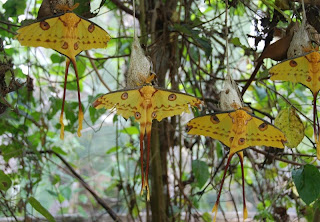Last Thursday we flew to Nosy Be, a small island off the North West coast of Madagascar. It has an International Airport and many European tourists come to the resorts on the island. It was immediately apparent that the island has benefited - it looks more prosperous - there are more bicycles for starters.
The Hotel Vanilla is on the beach and the thatched rooms are surrounded by lovely gardens. After the sea breeze came in, we walked down to the beach - a crescent of reasonable sand with a headland of black basaltic rocks at each end.
Some locals were exercising horses on the beach. Walking back to the hotel along the road we passed mango and jack fruit trees as well as Ylang Ylang plantations. These Indonesian trees are grown for their essential oil used in perfumery.
On Friday we went by catamaran to the small island of Nosy Komba famous for its semi tame black lemurs. Actually only the males are black, the females are brown with white faces. Apart from fishing and looking after tourists, the local villagers do Richelieu work and the designs incorporate lemurs and chameleons.
The catamarans were owned by a Frenchman who seemed to be building a thriving business. He said they were trying to get the hospital going again on Nosy Be. It does seem that the few remaining French take the lead in trying to develop the country.
Yesterday after we flew to Tana we visited the craft market. Stall after stall was selling marquetry, carved zebu horn, raffia bags and hats, Richelieu and coloured embroidery as well as semi precious stones.
This morning we visited Ambohimanga, the original capital of the Merina Royal family. The Merina from the Highlands conquered most of the island in the early nineteenth century and their Rova, or fortress palace is here. From this hilltop village there is a great view of the Hauts plateaux and Tana in the distance.
Our time in Madagascar is over and my next post will be from Reunion.
Looking down to the beach from the Hotel Vanilla
Entertainment in the Bistro at the Hotel Vanilla
Ylang Ylang trees - an important crop on Nosy Be.
Frangipani is actually a native of Mexico, but it snuck in here as it is one of my favourite flowers. I had it in my wedding bouquet.
School children relaxing on the beach at Nosy Be.
Outrigger canoe at Nosy Be.
Almost becalmed fishing boat.
Black lemurs
She looked so serious, but I am not sure what she is trying to achieve.
Malagasy people are experts at weaving raffia baskets (and hats)
Richelieu tablecloth - spot the lemur in the design.
Rusting machinery formerly used in the sugar cane industry. Four years ago the rum distillery was closed because the management was corrupt and now zebu graze on the fields.
Instead of the distillery, a large Protestant church is under construction.
The gateway at the entrance to Ambohimanga. Forty slaves used to roll the large stone across the gateway every night.
Part of the old summer palace of the Merina Kings.
In the Tsarasaoitra Bird Sanctuary, Antananarivo
View from the hotel in Tana.
A tyre repair workshop
A Halal butcher in Tana
Fancy a pizza?
The lamba is the most distinctive item of Malagasy clothing. They usually have a Malagasy proverb or words of wisdom in a box along the bottom. In the market, I caused great consternation, by asking for a French translation of the mottoes of the lambas I was buying. This particular one has the phrase "MAMY NY MODY" which means "Home sweet home"






































